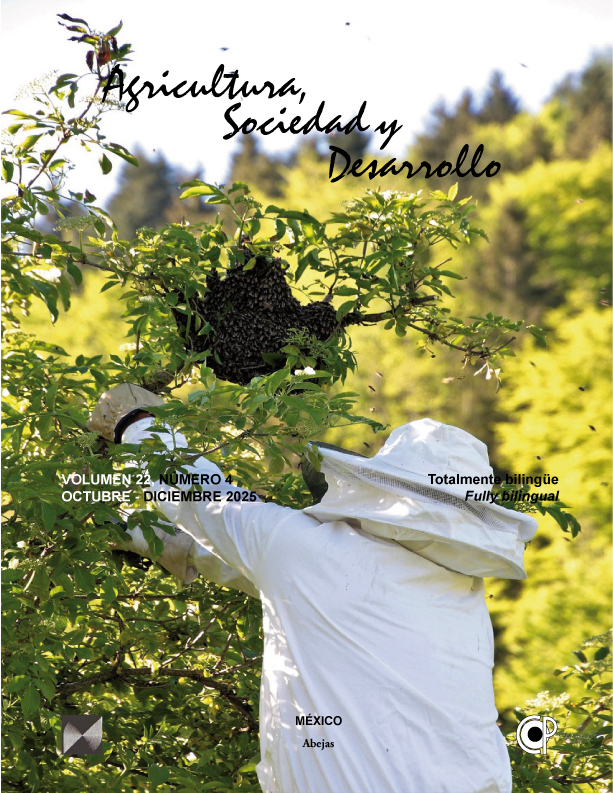Estimate of potential economic income from home gardens in Palenque, Chiapas, Mexico.
DOI:
https://doi.org/10.22231/asyd.v22i4.1724Keywords:
consumption, fruit, income, vegetables, vegetable gardensAbstract
The productive condition of the home gardens in the area does not contribute to reducing the costs of living of the families neither supply the products that the families require, because the sizes of the home gardens offer little productive guarantee. Therefore, this work aimed to estimate the economic and productive potential of family gardens in relation to the diversity of useful plants species present in the area. A semi-structured interview was applied to 43 heads of families. Depending on the size, the orchards were grouped as small, medium and large orchards. The monthly family consumption of fruit and vegetable products and their methods of obtaining were identified and the economic contribution generated by the implementation of a family vegetable home garden of 132 m2 in the Ejido Nueva Esperanza section first, Palenque Chiapas, was estimated. The production of each home garden and the economic contribution generated to the family were estimated; the income generated in the model vegetable garden was also estimated. It is concluded that families allocate up to 68% of their monthly income for the acquisition of consumer fruit and vegetable products, but working a garden of 132 m2 with short-cycle vegetables could obtain savings of up to 74%.
References
Alaimo K., Packnett E, Miles RA, Kruger DJ. 2008. Fruit and vegetable intake among urban community gardeners. Journal of Nutrition Education and Behavior, 40(2). 94-101. https://doi.org/10.1016/j.jneb.2006.12.003. DOI: https://doi.org/10.1016/j.jneb.2006.12.003
Algert S, Diekmann L, Renvall M, Gray L. 2016. Community and home gardens increase vegetable intake and food security of residents in San Jose, California. California Agriculture, 70(2). 77-82. https://doi.org/10.3733/ca.v070n02p77. DOI: https://doi.org/10.3733/ca.v070n02p77
Altieri MA. 1995. Agroecology. The science of sustainable agriculture. 2a ed. CRC Press. Boca Ratón, EEUU. https://doi.org/10.1201/9780429495465. 433 p. DOI: https://doi.org/10.1201/9780429495465
Altieri MA. 1999. Agroecología: bases científicas para una agricultura sustentable. Editorial Nordan-Comunidad: Montevideo, Uruguay. https://agroeco.org/wp-content/uploads/2010/10/Libro-Agroecologia.pdf. pp. 325.
Altieri MA, Funes-Monzote FR, Petersen P. 2012. Agroecologically efficient agricultural systems for smallholder farmers: Contributions to food sovereignty. Agronomy for Sustainable Development, 32. 1-13. https://doi.org/10.1007/s13593-011-0065-6. DOI: https://doi.org/10.1007/s13593-011-0065-6
Álvarez MC. 2012. Modelo de gestión para el manejo integrado de los recursos del solar familiar. In: El huerto familiar del sureste de México. Mariaca R. Ed. Secretaría de Recursos Naturales y Protección Ambiental del Estado de Tabasco, ECOSUR: Tabasco, México, https://www.researchgate.net/profile/Leopoldo-Medina-2/publication/236870993_El_huerto_familiar_del_sureste_de_Mexico/links/02e7e519c0b4aa7874000000/El-huerto-familiar-del-sureste-de-Mexico.pdf. pp. 435-459.
Bonilla-Aparicio ME, Salcido-Ramos BA, Paredes-Sánchez JA, Aguirre-Álvarez L, Méndez-Cadena ME, Hernández-Rodríguez ML. 2013. La diversidad hortícola para la seguridad alimentaria en municipios marginados del Estado de Puebla. Ra Ximhai 9(2). 151-163. https://doi.org/10.35197/rx.09.02.e.2013.11.mb. DOI: https://doi.org/10.35197/rx.09.02.e.2013.11.mb
Borbor M, Mercado W, Soplín H, Blas R. 2016. Importancia de los huertos familiares en la estrategia de diversificación del ingreso y en la conservación in situ de Pouteria lucuma [R et. Pav] O. Kze. Ecología Aplicada, 15(2). 179-187. http://dx.doi.org/10.21704/rea.v15i2.757 DOI: https://doi.org/10.21704/rea.v15i2.757
Cahuich-Campos D. 2012. El huerto maya y la alimentación cotidiana de las familias campesinas de X-Mejía, Hopelchén, Campeche. In: El huerto familiar del sureste de México. Mariaca R, Ed. Secretaría de Recursos Naturales y Protección Ambiental del Estado de Tabasco, ECOSUR: Tabasco, México, https://www.researchgate.net/profile/ Leopoldo-Medina-2/publication/236870993_El_huerto_familiar_del_sureste_de_Mexico/links/02e7e519c0b4aa7874000000/El-huerto-familiar-del-sureste-de-Mexico.pdf. pp: 197- 229.
Cano EJ. 2015. Huertos familiares: un camino hacia la soberanía alimentaria. Revista Pueblos y Fronteras Digital. 10(20). 70-91. https://doi.org/10.22201/cimsur.18704115e.2015.20.33. DOI: https://doi.org/10.22201/cimsur.18704115e.2015.20.33
Castañeda-Navarrete J. 2021. Homegarden diversity and food security in southern Mexico. Food security, 13(3). 669-683. https://doi.org/10.1007/s12571-021-01148-w. DOI: https://doi.org/10.1007/s12571-021-01148-w
Chávez E. 2012. Desarrollo modernizador y manejo tradicional del huerto familiar: dos paradigmas diferentes. In: El huerto familiar del sureste de México. Mariaca R, Ed. Secretaría de Recursos Naturales y Protección Ambiental del Estado de Tabasco, ECOSUR: Tabasco, México, https://www.researchgate.net/profile/Leopoldo-Medina-2/publication/236870993_El_huerto_familiar_del_sureste_de_Mexico/links/02e7e519c0b4aa7874000000/El-huerto-familiar-del-sureste-de-Mexico.pdf. pp: 391-419.
Chi-Quej JA. 2009. Caracterización y manejo de los huertos caseros familiares en tres grupos étnicos (Mayas peninsulares, Choles y Mestizos) del Estado de Campeche, México. Tesis de maestría. Escuela de Posgrado, Centro Agronómico Tropical de Investigación y Enseñanza, Turrialba, Costa Rica. https://docs.repositoriobiocultural.org/2021/08/27/caracterizacion-y-manejo-de-los-huertos-caseros-familiares-en-tres-grupos-etnicos-mayas-peninsulares-choles-y-mestizos-del-estado-de-campeche-mexico/.
Cobo R y Paz L. 2017. Traspatios campesinos de Morelos. Textual, (70). 51-68. https://doi.org/10.5154/r.textual.2017.70.004. DOI: https://doi.org/10.5154/r.textual.2017.70.004
Cruz LA. 2016. El papel de las mujeres en los huertos familiares. Revista Alternativas en Psicología, (36). 46-60. https://alternativas.me/wp-content/uploads/2016/11/El-papel-de-las-mujeres-en-los-huertos-familiares.pdf.
Dussel E. 2014. 16 tesis de economía política: interpretación filosófica. Siglo XXI editores. México. https://enriquedussel.com/txt/Textos_Obras_Selectas/(F)28.16_Tesis_economia_politica. pdf. 424 p.
Espinosa P, Gutiérrez R, Espinosa LM. 2010. 1. El huerto familiar. SAGARPA. México. https://ecotec.unam.mx/wp-content/uploads/SAGARPA.-Huerto-familiar.pdf. 10 p.
FAO. 2000. Mejorando la nutrición a través de huertos y granjas familiares. Manual de capacitación para trabajadores de campo en América Latina y El Caribe. FAO: Roma, Italia, http://www.fao.org/docrep/V5290S/v5290s00.htm. 139 p.
Farfán-García AG, Navarrete-Pita Y, Mendoza-Mero AE. 2022. Creación de huertos familiares para el desarrollo de la seguridad alimentaria en la ciudadela Panorama. Revista Estudios del Desarrollo Social: Cuba y América Latina, 10(1). 1-17. https://dialnet.unirioja.es/servlet/articulo?codigo=8517950.
García-Flores JC, Gutiérrez-Cedillo JG, Balderas-Plata MA, Araújo-Santana MR. 2016. Estrategia de vida en el medio rural del altiplano central mexicano: el huerto familiar. Agricultura, Sociedad y Desarrollo, 13(4). 621-641. https://www.revista-asyd.org/index.php/asyd/article/view/498. DOI: https://doi.org/10.22231/asyd.v13i4.498
García-Palomares J. 2010. Integración de innovaciones tecnológicas en el desarrollo del sistema producto chile de Chiapas. Fundación PRODUCE Chiapas A.C. 70 p.
Gerardo-Méndez C, Ramírez-Martínez A, Ruiz-Rosado O y Álvarez-Ávila MC. 2022. Aportes del agroecosistema en la seguridad alimentaria durante la pandemia Covid-19 en el sureste de México. Estudios Sociales. Revista de Alimentación Contemporánea y Desarrollo Regional. 32(60). 1-27. https://doi.org/10.24836/es.v32i60.1240 DOI: https://doi.org/10.24836/es.v32i60.1240
Gliessman SR. 2002. Agroecología: Procesos ecológicos en agricultura sostenible. Centro Agronómico Tropical de Investigación y Enseñanza (CATIE). LITOCAT: Turrialba, Costa Rica, https://biowit.files.wordpress.com/2010/11/agroecologia-procesos-ecolc3b3gicos-en-agricultura-sostenible-stephen-r-gliessman.pdf. 359 p.
Gómez B. 2010. Potencial agroecológico de los huertos familiares en el municipio de H. Cárdenas, Tabasco: Permanencia y prospectivas de desarrollo. Tesis de maestría. Colegio de Postgraduados. Montecillo. Texcoco. México. http://colposdigital.colpos.mx:8080/xmlui/handle/10521/178
González A. 2007. Agroecosistemas mexicanos: pasado y presente. Itinerarios. 6. 55-80. https://itinerarios.uw.edu.pl/resources/html/article/details?id=224357&language=es.
Gutiérrez JG, White, L, Juan JI, Chávez M.C. 2015. Agroecosistemas de huertos familiares en el subtrópico del altiplano mexicano. Una visión sistémica. Tropical and Subtropical Agroecosystems 18(3). 237-250. https://www.redalyc.org/articulo.oa?id=93944043012. DOI: https://doi.org/10.56369/tsaes.1844
Hylander K, Nemomissa S. 2008. Home garden coffee as a repository of epiphyte biodiversity in Ethiopia. Frontiers in Ecology and the Environment, 6. 524-528. https://doi.org/10.1890/080001. DOI: https://doi.org/10.1890/080001
Ibarra JT, Caviedes J, Barreau A, Pessa N. (eds). 2019. Huertas familiares y comunitarias: cultivando soberanía alimentaria. Universidad Católica de Chile: Santiado de Chile, https://opia.fia.cl/601/articles-99232_archivo_01.pdf. 228 p. DOI: https://doi.org/10.2307/j.ctvkrkkbx
INDESOL, Tierra Verde. 2013. Manual de Huertos Orgánicos de Traspatio. https://www.scribd.com/document/495829064/Manual-de-Huertos-Organicos-de-Traspatio-2013. 14 p.
INEGI 2020. Censo de población y vivienda. México. https://www.inegi.org.mx/programas/ccpv/2020/.
Kewessa G. 2020. Homegarden agroforestry as a tool for sustainable production unit in Ethiopia. Journal of Resources Development and Management, 67. 14-19. https://doi.org/10.7176/JRDM/67-02. DOI: https://doi.org/10.7176/JRDM/67-02
Krishnamurthy LR, Krishnamurthy S, Rajagopal I, Peralta A. 2017. Agricultura familiar para el desarrollo rural incluyente. Terra Latinoamericana, 35(2). 135-147. https://www.scielo.org.mx/scielo.php?script=sci_arttext&pid=S0187-57792017000200135. DOI: https://doi.org/10.28940/terra.v35i2.145
Lerner T, Mariaca R, Salvatierra B, González-Jácome A, Wahl E. 2009. Aporte de alimentos del huerto familiar a la economía campesina Ch’ol, Suclumpá, Chiapas, México. Etnobiología, 7(1). 30-44. https://revistaetnobiologia.mx/index.php/etno/article/view/251/252.
Maroyi A. 2009. Traditional homegardens and rural livelihoods in Nhema, Zimbabwe: a sustainable agroforestry system. International Journal of Sustainable Development & World Ecology, 16(1), 1-8. https://doi.org/10.1080/13504500902745895. DOI: https://doi.org/10.1080/13504500902745895
Mattsson E, Ostwald M, Nissanka SP. 2018. What is good about Sri Lankan homegardens with regards to food security? A synthesis of the current scientific knowledge of a multifunctional land-use system. Agroforestry Systems, 92. 1469-1484. https://doi.org/10.1007/s10457-017-0093-6. DOI: https://doi.org/10.1007/s10457-017-0093-6
Moreno-Moreno RA, Orantes-G C, Cortes-P JR, Sánchez-C MS. 2020. Uso florístico de los huertos familiares y sus beneficios en la selva El Ocote, Chiapas. Revista Pakbal, (48). 27-31. https://www.ingenieria.unach.mx/index.php/investigadores/2-uncategorised/157-revista-pakbal-48.
Pantoja, A. 2014. Una Huerta para todos: Manual de Autoinstrucción. FAO. Quinta edición. Chile. https://www.fao.org/family-farming/detail/es/c/317903/. 295 p.
Park JH, Woo SY, Kwak MJ, Lee JK, Leti S, Soni T. 2019. Assessment of the diverse roles of home gardens and their sustainable management for livelihood improvement in West Java Indonesia. Forests 10(11). 970. https://doi.org/10.3390/f10110970. DOI: https://doi.org/10.3390/f10110970
Pulido MT, Pagaza-Calderón EM, Martínez-Ballesté A, Maldonado-Almanza B, Saynes A, Pacheco RM. 2008. Home gardens as an alternative for sustainability: challenges and perspectives in Latin America. Current Topics in Ethnobotany. 37(2). 1–25. https://web2.uaeh.edu.mx/investigacion/icbi/LI_ProdForestales/MaTeresa_Pulido/MTP_7_Pulido.pdf.
Reyes-Betanzos A, Álvarez-Ávila MC. 2017. Agrobiodiversidad, manejo del huerto familiar y contribución a la seguridad alimentaria. Agro Productividad. 10(7). 58-63. https://www. revista-agroproductividad.org/index.php/agroproductividad/article/view/1058/905.
Rivas G. 2014. Huertos familiares: para la conservación de la agrobiodiversidad, la promoción de la seguridad alimentaria y la adaptación al cambio climático. Ambientico, (243). 4-9. https://www.ambientico.una.ac.cr/wp-content/uploads/tainacan-items/5/25464/243_4-9.pdf.
Román E, Oviedo U, García A, Ayala MI. 2024. Participación de la mujer en los traspatios como alternativa de soberanía alimentaria. Estudios Rurales, 14(29). https://doi.org/10.48160/22504001er29.499. DOI: https://doi.org/10.48160/22504001er29.499
SEMARNAT. 2013. El huerto familiar biointensivo. Introducción al método de cultivo biointensivo, alternativa para cultivar más alimentos en poco espacio y mejorar el suelo. Primera reedición; SEMARNAT: Tlalpan, México, D.F., https://biblioteca.semarnat.gob.mx/janium/Documentos/Ciga/Libros2013/CD001599.pdf. 52 p.
Sol, A. 2012. El papel económico de los huertos familiares y su importancia en la conservación de las especies y variedades locales. In: El huerto familiar del sureste de México. Mariaca R. Ed. Secretaría de Recursos Naturales y Protección Ambiental del Estado de Tabasco, ECOSUR: Tabasco, México, https://www.researchgate.net/profile/Leopoldo-Medina-2/publication/236870993_El_huerto_familiar_del_sureste_de_Mexico/links/02e7e519c0b4aa7874000000/El-huerto-familiar-del-sureste-de-Mexico.pdf. pp: 361- 370.
Toledo V, Barrera-Bassols N, García-Frapolli E, Alarcón-Chaires P. 2008. Uso múltiple y biodiversidad entre los mayas yucatecos (México). Interciencia. 33(5). 345-352. http://www.unich.edu.mx/wp-content/uploads/2014/01/usos%20multiples%20y%20biodiversidad%20maya.pdf.
Weinberger K. 2013. Home and community gardens in Southeast Asia: potential and opportunities for contributing to nutrition-sensitive food systems. Food Security, 5: 847–856. https://doi.org/10.1007/s12571-013-0299-z. DOI: https://doi.org/10.1007/s12571-013-0299-z
White-Olascoaga L, Chávez-Mejía C, García-Mondragón D. 2017. Análisis del estrato arbóreo de agroecosistemas en una zona de transición ecológica. Ecosistemas y Recursos Agropecuarios, 4(11). 255-264. https://doi.org/10.19136/era.a4n11.882. DOI: https://doi.org/10.19136/era.a4n11.882
Published
How to Cite
Issue
Section
License
Copyright (c) 2025 Margarito Salvador Hernández, Ángel Sol Sánchez, Juan Manuel Zaldivar-Cruz, Nydia Del Rivero Bautista, Facundo Sanchez Gutiérrez

This work is licensed under a Creative Commons Attribution-NonCommercial 4.0 International License.
Authors who publish in this journal accept the following conditions:
- The authors retain the copyright and transfer to the magazine the right of the first publication, with the work registered with the Creative Commons attribution license, which allows third parties to use what is published as long as they mention the authorship of the work and the first publication in this magazine.
- Authors may make other independent and additional contractual arrangements for non-exclusive distribution of the version of the article published in this journal (e.g., including it in an institutional repository or publishing it in a book) as long as they clearly indicate that the work It was first published in this magazine.
- Authors are permitted and encouraged to publish their work on the Internet (for example on institutional or personal pages) before and during the review and publication process, as it can lead to productive exchanges and greater and faster dissemination of the work. published (see The Effect of Open Access).













